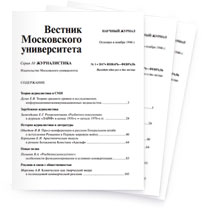Factors Affecting Reading Time and Scroll Depth of Online Media Articles (the Case of Lady.mail.ru)
Download paperProduct Manager at Yandex Technologies Ltd, Moscow, Russia
e-mail: lyubimtseva.m@gmail.comSection: Sociology of Journalism
This paper deals with the definitions of engagement and key indicators, such as reading time and scroll depth, which measure readers’ engagement in online media. The theoretical basis of the research includes different variations of the engagement concept and its metrics, and also an overview of audience engagement factors that, according to researchers, affect reading time and readability of content. The empirical base of the research is the results of the content analysis of Lady.mail.ru articles for sixteen factors, and ultimately the results of the regression analysis of this data set and the conclusions about the significance of the factors in terms of engagement. The engagement indicators, such as engagement rate and scroll depth percentage, are taken from Mail.ru Group analytics system and make it possible to compare articles of different lengths. The results of this research will help media managers and authors to improve their approach to design, text length and layout. It was found that engagement decreases with the increase in the volume of the text and its advertising nature. The lack of visual elements in the text negatively affects engagement. The popularity of the article contributes to the fact that it will be read down to the end, while the headlines do not affect engagement in any way.
DOI: 10.30547/vestnik.journ.2.2020.5384References:
Attfield S., Kazai G., Lalmas M., Piwowarski B. (2011) Towards a Science of User Engagement (Position Paper). In Conference Paper. WSDM’11, 9–12 Feb. Hong Kong, China.
Balmaeva S., Lukina M. (eds.) (2016) Kak novye media izmenili zhurnalistiku. 2012—2016 [How New Media Have Changed Journalism]. Ekaterinburg: Gumanitarnyy universitet. (In Russian)
Bucher H-J., Schumacher P. (2006) The Relevance of Attention for Selecting News Content: an Eye-Tracking Study on Attention Patterns in the Reception of Print and Online Media. Communications 31 (3): 347–368. DOI: 10.1515/COMMUN.2006.022
Bulatova E. V. (2010) Diskursivnye formy reklamy [Discursive Forms of Advertising]. Izvestiya Ural’skogo gosudarstvennogo universiteta. Ser. 1: Problemy obrazovaniya, nauki i kul’tury 4 (81): 124–129. (In Russian)
Claussen J., Kretschmer T., Mayrhofer P. (2013) The Effects of Rewarding User Engagement – The Case of Facebook Apps. Information Systems Research 24 (1): 186–200. Available at: https://ssrn.com/abstract=1599458 (accessed: 18.03.2020). DOI: http://dx.doi.org/10.2139/ssrn.1599458
Di Gangi P., Wasko M. (2016) Social Media Engagement Theory: Exploring the Influence of User Engagement on Social Media Usage. Journal of Organizational and End User Computing 28: 53–73. DOI: 10.4018/JOEUC.2016040104
Duchowski A. T. (2003) Eye Tracking Methodology: Theory and Practice. London: Springer-Verlag.
Gradyushko A. A. (2019) Osnovy tvorcheskoy deyatel’nosti veb-zhurnalista: ucheb.-metod. posobie [Fundamentals of a Web Journalist’s Creative Work: a Study Guide]. Minsk: BGU. (In Russian)
Grömping U. (2006) Relative Importance for Linear Regression in R: the Package Relaimpo. Journal of Statistical Software 17 (1).
Hedman J. (2003) Läsning av nyhetssidor på nätet (Reading of News on the Net). Master’s thesis. Dept. of Information Science. Uppsala University. Sweden.
Il’in E. P. (2000) Motivatsiya i motivy [Motivation and Motives]. Saint Petersburg: Piter. (In Russian)
Jaakonmäki R., M ller O., vom Brocke J. (2017) The Impact of Content, Context, and Creator on User Engagement in Social Media Marketing. HICSS. DOI: 10.24251/HICSS.2017.136
Kostina D. M. (2016) Vospriyatie zagolovkov pechatnykh i elektronnykh SMI: po dannym psikholingvisticheskogo eksperimenta: magisterskaya dissertatsiya [Perception of Headlines in Print and Online Media: Based on the Data from a Psycholinguistic Experiment: Master’s thesis]. (In Russian). Available at: http://vital.lib.tsu.ru/vital/access/manager/Repository/vital:3669 (accessed: 06.03.2020).
Lagun D., Lalmas M. (2016) Understanding and Measuring User Engagement and Attention in Online News Reading. In Conference Paper. WSDM’16, 22–25 Febr. San Francisco, CA, USA.
Leckner S. (2012) Presentation Factors Affecting Reading Behavior in Readers of Newspaper Media: an Eye-Tracking Perspective. Visual Communication 11 (2): 163–184. DOI: https://doi.org/10.1177/1470357211434029
Lehmann J., Lalmas M., Yom-Tov E., Dupret G. (2012) Models of User Engagement. In J. Masthoff, B. Mobasher, M. C. Desmarais, R. Nkambou (eds.) User Modeling, Adaptation, and Personalization. UMAP 2012. Lecture Notes in Computer Science, vol. 7379. Berlin, Heidelber: Springer. DOI: https://doi.org/10.1007/978-3-642-31454-4_14
Lukina M. M. (ed.) (2010) Internet-SMI: teoriya i praktika: uchebnoe posobie dlya studentov vuzov [Online Media: Theory and Practice: a Study Guide for University Students]. Moscow: Aspekt Press. (In Russian)
Mersey R. D., Malthouse E. C., Calder B. J. (2010) Engagement with Online Media. Journal of Media Business Studies 7 (2): 39–56. DOI: 10.1080/16522354.2010.11073506
Morita M., Shinoda Y. (1994) Information Filtering Based on User Behavior Analysis and Best Match Text Retrieval. Conference Paper. In SIGIR’94: Proceedings of the Seventeenth Annual International ACM-SIGIR Conference of Research and Development in Information Retrieval, Organic School of Information Science. Japan Advanced Institute of Science and Technology. Japan. Pp. 272– 281. DOI: 10.1007/978-1-4471-2099-5_28
Napoli P. M. (2011) Audience Evolution: New Technologies and the Transformation of Media Audiences. New York.
Nikitenko A. A. (2009) Interaktivnost’, mul’timediynost’, gipertekstual’ nost’ kak determiniruyushchie tipologicheskie priznaki setevykh izdaniy [Interactivity, Mutimediality, Hypertextuality as Crucial Typological Features of Online Publications]. Vestnik VGU. Seriya: Filologiya. Zhurnalistika 1: 159–166. (In Russian)
Nikolaeva A. V. (2019) Jazykovye osobennosti fejkovyh publikacij [Linguistic Characteristics of Fake Media Texts]. Verhnevolzhskij filologicheskij vestnik 3. (In Russian). Available at: https://cyberleninka.ru/article/n/yazykovye-osobennosti-feykovyh-publikatsiy (accessed: 03.04.2020). DOI: 10.24411/2499-9679-2019-10482
O’Brien H. L., Toms E. G. (2008) What Is User Engagement? A Conceptual Framework for Defining User Engagement with Technology. Journal of the American Society for Information Science and Technology 59 (6): 938–955. DOI: https://doi.org/10.1002/asi.20801
Ray S., Kim S. S., Morris J. G. (2014) The Central Role of Engagement in Online Communities. Information Systems Research 25 (3): 528–546.
Russell M. G. (2009) A Call for Creativity in New Metrics for Liquid Media. Journal of Interactive Advertising 9 (2): 44–61. DOI: https://doi.org/10.1080/15252019.2009.10722155
Terpugova E. A. (2000) Reklamnyj tekst kak osobyj tip imperativnogo diskursa: dis. ... kand. filol. nauk. [An Advertising Text as a Special Type of Imperative Discourse: PhD philol. sci. diss.] Irkutsk. (In Russian)






